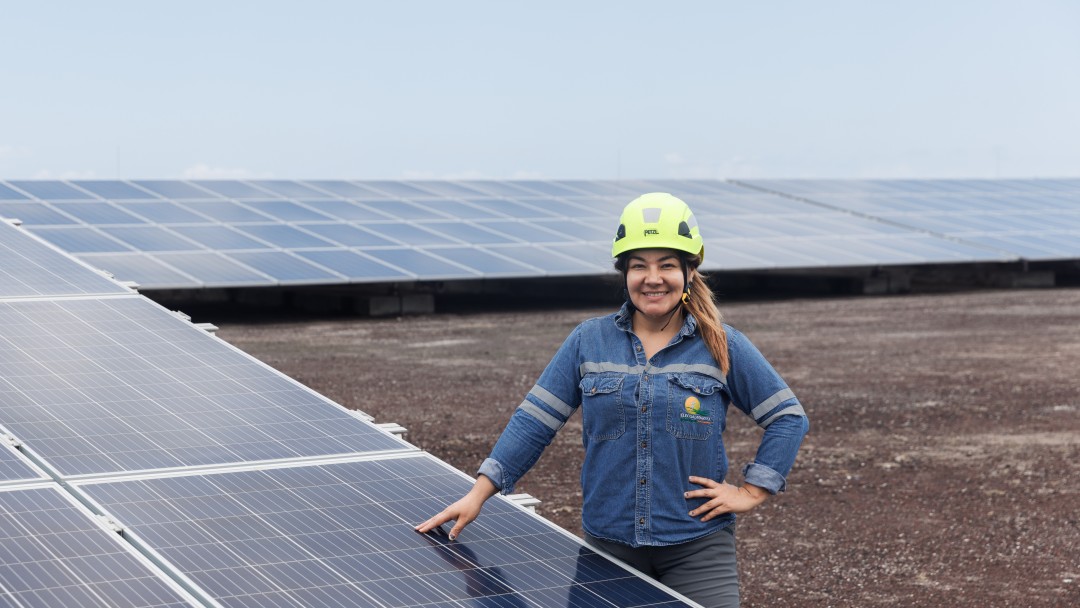
The Galapagos archipelago is a UNESCO World Heritage Site and is under strict protection as an island of evolution due to its unique flora and fauna – because the archipelago is affected by all the negative side effects of our civilisation, such as climate change, sea level rise, species extinction, oil spills and plastic littering. The world-famous islands have been repeatedly confronted with massive pollution due to oil tanker accidents - tankers that were also travelling to Galapagos to supply power plants. Following the accident involving the tanker "Jessica" in January 2001, around three million litres of oil spilled into the sea off the Galapagos island of San Cristobal. Over 10,000 endemic marine iguanas and other marine life died as a result. The Ecuadorian government then launched the "Zero Fossil Fuel for Galapagos Islands" initiative in 2007 – in order to reduce marine pollution and continue to be allowed to use the World Heritage seal for the Galapagos archipelago.
On the island of Isabela – the largest of the 21 islands in the archipelago – KfW Development Bank is financing a hybrid power plant on behalf of the German Federal Ministry for Economic Cooperation and Development (BMZ) that will reliably supply around 3,000 inhabitants and numerous tourists with 100 % electricity from renewable energies in the future. The power plant has been in operation since 2019 and is now to be expanded in a second phase. KfW is providing the Ecuadorian Ministry of Electricity and Renewable Energy (MEER) with a total of EUR 15.8 million as a grant for the power plant. The generators are still running on conventional diesel, but the plan is to switch to biodiesel.
Leuris Garcés, who introduces herself and her work below, is responsible for the operation and maintenance of the power plant.
My name is Leuris Garcés and I am responsible for the operation and maintenance of the hybrid power plant on Isabela. I'm an electronics engineer and I've been working here for six years – that's about how long the power plant has been in operation. It consists of a thermal power plant and a photovoltaic system that supplies the 3,000 inhabitants and an additional 3,000 to 4,000 tourists with energy every month. Isabela is a hotel island, we have quite a lot hotels, but very little industry.
The power plant consists of a 952 kilowatt (kW) photovoltaic system; a lithium battery with a capacity of 330 kilowatt hours (kWh) and an output of 660 kW; and five Flex Fuel Scania engines with 325 kW each. The energy requirement is around 1,400 kW, during the day we contribute around 800 kW with the photovoltaic system and around 600 kW with thermal generation.
I work with ten colleagues at the power plant, six maintenance staff, two technicians, a warehouse manager and a shift supervisor. The shift manager changes every six hours and the power plant is never left alone.
How did I end up here? My childhood dream was to become a flight attendant, but my parents introduced me to the engineering profession – and today I'm glad they did.
I'm happy that I can show that women can do the same work as men. Everyday working life is not always without its tensions. Young people and older people work together at the power plant, and sometimes it's not easy for older colleagues to cope with changes in technology and administration.
What am I proud of? It's a great feeling when we switch off diesel operation, because the aim of the plant is to avoid CO2 emissions. At off-peak times, we achieve six to seven hours of "diesel off". When I came to the plant for the first time in 2019 and we had four hours of diesel off in a row, it was a great feeling. I am grateful that I can contribute to increasing the proportion of renewable energy – for the residents and tourists, but of course also for the unique fauna and flora here in the archipelago.
We are all very pleased that we are now entering a second phase of the project. It will then be possible to store solar energy and feed it in at night so that less diesel is burned. Looking forward: We hope that diesel can be replaced by a sustainable biofuel in the future. The decision has been made in favour of jatropha oil. This is produced by a cooperative of 3,000 small farmers in the semi-arid Ecuadorian coastal region of Manabi with the help of a decentralised cold-press oil mill and shipped 1,000 kilometres to Galapagos. Jatropha oil is non-edible – meaning there is no "tank-plate conflict".
As an engineer at the power plant, I am not the only one who is pleased about the switch to renewable energies. The power plant is perceived very positively by the population. The project has a strong signaling effect and is part of the national "Cero Combustibiles Fossiles" strategy (zero fossil fuels) – it thus makes a decisive contribution to climate protection.
Share page
To share the content of this page with your network, click on one of the icons below.
Note on data protection: When you share content, your personal data is transferred to the selected network.
Data protection
Alternatively, you can also copy the short link: https://www.kfw-entwicklungsbank.de/s/enzBwP8W
Copy link Link copied